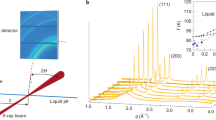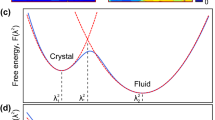Abstract
In experiments1,2,3 where intense radiation penetrates into the bulk of a solid and causes ultrafast (femtosecond) heating, the superheated crystalline solid melts from within at a temperature above the equilibrium melting temperature. But what happens on the atomic scale as a solid loses crystalline order remains an open question. Molecular dynamics modelling allows the position of every atom to be traced at each instant, as a crystal transforms from solid to liquid. Here we use such detailed atomistic simulations, relevant for aluminium, to show that the thermal fluctuation initiating melting is an aggregate typically with 6–7 interstitials and 3–4 vacancies. This mechanism differs from those that have traditionally been proposed, which generally involve many more atoms at the initial melting stage.
This is a preview of subscription content, access via your institution
Access options
Subscribe to this journal
Receive 12 print issues and online access
$259.00 per year
only $21.58 per issue
Buy this article
- Purchase on Springer Link
- Instant access to full article PDF
Prices may be subject to local taxes which are calculated during checkout




Similar content being viewed by others
References
Siwick, B. J., Dwyer, J. R., Jordan, R. E. & Dwayne Miller, R. J. An atomic-level view of melting using femtosecond electron diffraction. Science 302, 1382–1385 (2003).
Luo, S. -N. & Ahrens, T. J. Superheating systematics of crystalline solids. Appl. Phys. Lett. 82, 1836–1838 (2003).
Sokolowski-Tinten, K. et al. Femtosecond X-ray measurement of coherent lattice vibrations near the Lindemann stability limit. Nature 422, 287–289 (2003).
Poirier, J. -P. Introduction to the Physics of the Earth's Interior (Cambridge Univ. Press, Cambridge, 1991).
Boyer, L. L. Theory of melting based on lattice instability. Phase Transit. (UK) 5, 1–48 (1985).
Cahn, R. W. Melting from within. Nature 413, 582–583 (2001).
Brillouin, L. On thermal dependence of elasticity in solids. Phys. Rev. 54, 916–917 (1938).
Born, M. Thermodynamics of crystals and melting. J. Chem. Phys. 7, 591–603 (1939).
Mizushima, S. Dislocation models of liquid structure. J. Phys. Soc. Jpn 15, 70–77 (1960).
Kuhlmann-Wilsdorf, D. Theory of melting. Phys. Rev. A 140, 1599–1610 (1965).
Lindemann, F. A. Über die Berechnung molekylarer Eigenfrequenzen. Z. Phys. 11, 609–612 (1910).
Gilvarry, J. J. The Lindemann and Grüneisen laws. Phys. Rev. 102, 308–316 (1956).
Jin, Z. H. & Lu, K. Melting as a homogeneously nucleated process within crystals undergoing superheating. Z. Metallkd. 91, 275–279 (2000).
Jin, Z. H., Gumbsch, P., Lu, K. & Ma, E. Melting mechanisms at the limit of superheating. Phys. Rev. Lett. 87, 055703–1–4 (2001).
Allen, M. P. & Tildesley, D. J. Computer Simulation of Liquids (Oxford Univ. Press, Oxford, 1987).
Forsblom, M., Sandberg, N. & Grimvall, G. Anharmonic effects in the heat capacity of Al. Phys. Rev. B 69, 165106 (2004).
Ercolessi, F. & Adams, J. B. Interatomic potentials from first-principles calculations: the force-matching method. Europhys. Lett. 26, 583–588 (1994).
Morris, J. R. & Song, X. The melting lines of model systems calculated from coexistence simulations. J. Chem. Phys. 116, 9352–9358 (2002).
Parrinello, M. & Rahman, A. Strain fluctuations and elastic constants. J. Chem. Phys. 76, 2662–2666 (1982).
Nordlund, K. & Averback, R. S. Role of self-interstitial atoms on the high temperature properties of metals. Phys. Rev. Lett. 80, 4201–4204 (1998).
Kogure, Y., Kosugi, T. & Doyama, M. Simulation for mechanical relaxation and interaction of point defects. Mater. Sci. Eng. A 370, 100–104 (2004).
Granato, A. V. Interstitialcy model for condensed matter states of face-centered-cubic metals. Phys. Rev. Lett. 68, 974–977 (1992).
Kanigel, A., Adler, J. & Polturak, E. Influence of point defects on the shear elastic coefficients and on the melting temperature of copper. Int. J. Mod. Phys. C 12, 727–737 (2001).
Acknowledgements
We thank N. Sandberg for useful discussions. This work has received funding from the Swedish research foundation SSF under the project ATOMICS.
Author information
Authors and Affiliations
Corresponding author
Ethics declarations
Competing interests
The authors declare no competing financial interests.
Rights and permissions
About this article
Cite this article
Forsblom, M., Grimvall, G. How superheated crystals melt. Nature Mater 4, 388–390 (2005). https://doi.org/10.1038/nmat1375
Received:
Accepted:
Published:
Issue Date:
DOI: https://doi.org/10.1038/nmat1375
This article is cited by
-
Mean-field model of melting in superheated crystals based on a single experimentally measurable order parameter
Scientific Reports (2021)
-
Diffusive and martensitic nucleation kinetics in solid-solid transitions of colloidal crystals
Nature Communications (2017)
-
Mesoscopic structural phase progression in photo-excited VO2 revealed by time-resolved x-ray diffraction microscopy
Scientific Reports (2016)
-
Direct observation of liquid nucleus growth in homogeneous melting of colloidal crystals
Nature Communications (2015)
-
Experimental observation of defect pair separation triggering phase transitions
Scientific Reports (2014)



